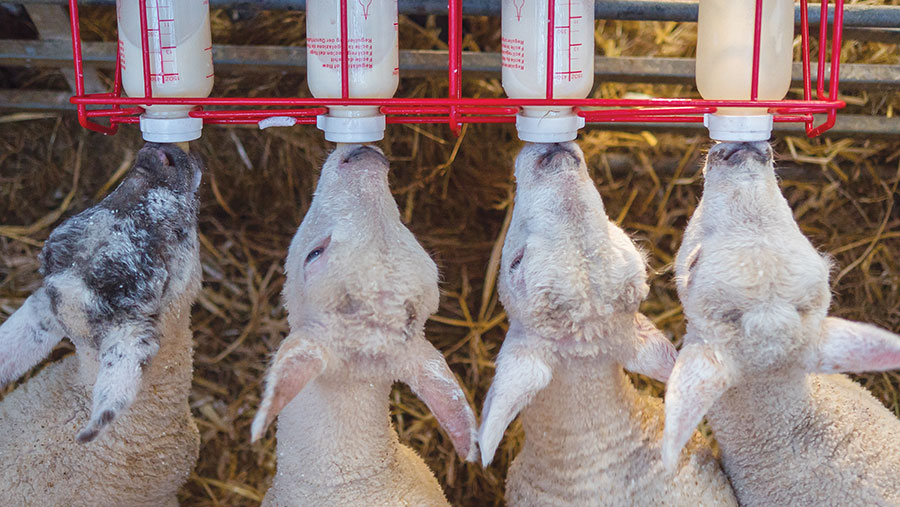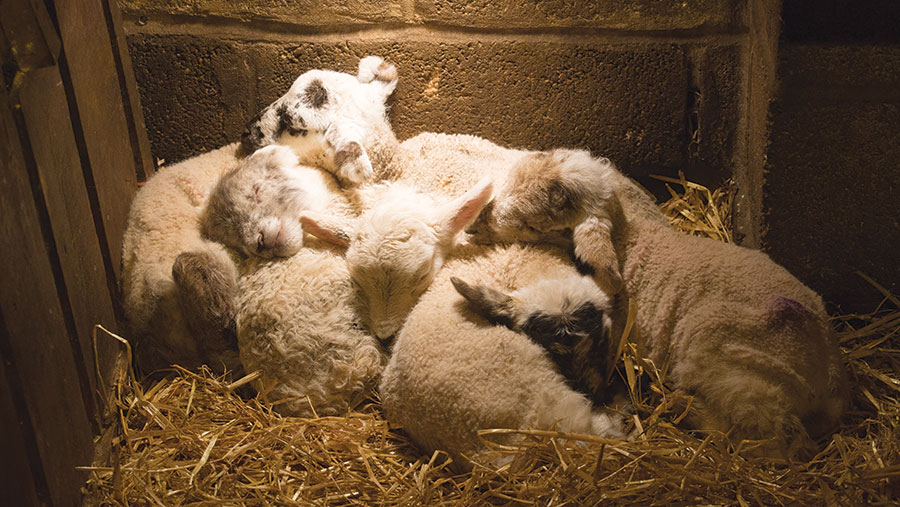6 things to consider when feeding lambs milk replacer
 © Adobe Stock
© Adobe Stock Artificially rearing orphan and multiple lambs puts pressure on labour and production costs, but sheep farmers who get this system right will boost their lamb crops.
Reliable and consistent nutrition is key to lamb survival and growth, whether it comes from the ewe or a milk replacer.
For lambs reared on bottles and machines, vet Miranda Timmerman recommends feeding lamb milk replacer, instead of wasting cow’s milk.
See also: Advice on managing surplus lambs
Ewe’s milk has a much higher constituent percentage than cow’s milk.
Below, Ms Timmerman gives advice on choosing a milk replacer.
1. Skim or whey-based powders?
Whether the product is skim or whey-based, a high level of animal protein is key.
“It would be counterproductive to feed a cheap powder because lambs won’t take in enough nutrients and energy, so they will wean later.’’
2. What to look for on the label
Ingredients are ranked in order of inclusion rate, with the major ingredient listed at the top.
Whey is at the top of the list on most lamb milk replacers, with skim the second most dominant ingredient.
For protein and butterfat, Ms Timmerman says the ideal rates are 30% fat and a minimum of 23% protein.
“Milk protein is needed for muscle growth – the higher the percentage, the faster the growth period – and fat is the energy source and gives the lamb the ability to lay down muscle,” she adds.
Crude fibre should be as low as possible – ideally no higher than 0.05%. A rate higher than 0.15% is indicative of the product containing plant protein, which is less digestible to young ruminants than animal protein.
3. Feeding rates up to weaning
Feed between 1-1.5 litres/day across four feeds – 1.5 litres is the upper limit, but should not be given before a lamb is one week old.
Multiple feeds reduce the risk of bloat – little and often prevents gorging.
With machine rearing, individual intakes are not guaranteed, so be vigilant for hollow or lethargic lambs.
“Lambs mostly run around because they are full of warm milk, if not there will be a reason for this,” says Ms Timmerman.
In most systems, lambs are weaned abruptly at five weeks – there is no evidence to suggest that growth rates will be compromised.

© Tim Scrivener
4. Milk-mixing protocols
Replacers have guidance on the bag but there are two important points to consider – the product must be added to the measuring jug before the water and water must be at the correct temperature.
“If you add water to the jug first followed by the powder to make up the recommended quantity you will water it down, we see this mistake being made time and time again,” warns Ms Timmerman.
Individual products will have their own guidance on what the water temperature for feeding and mixing should be, so read the label.
Ideally, milk should be fed at 39C and water should never be warmer than 45°C at the mixing stage or the heat will denaturise the protein.
Replacer can be fed cold, but only to lambs older than three weeks and they must have consistent access to it because they are more likely to get bloat.
5. Supplementary feeding
Offer creep feed at 10-14 days old and refresh it every day or so to ensure it remains palatable. Also offer water.
Lambs will often be bedded on straw, but provide haylage in a rack for them to nibble on to help prepare rumen bugs for higher intakes of forage, unless the lambs are to be finished intensively.
6. Hygiene considerations
Disease risk is higher in lambs on milk replacer systems because they have lower immunity than ewe-reared lambs and will be mixing closely with others.
Hygiene needs to be excellent to prevent coccidiosis and E coli. Milk pipes should also be washed daily, with a cold wash first to ensure no fat sticks in them. This should then be followed by a boiling hot wash. Hypochlorite can also be used, but the pipes must be rinsed well afterwards. Other disinfectants can also be used.
Areas around creep feeding troughs and milk machines can also get soggy and should be cleaned.
See also: Our guide to what’s on the market when it comes to automatic milk machines.
Thanks to Volac, whose sponsorship made it possible to run this article. Farmers Weekly had full editorial control of this report.
Sponsor’s message
 Thanks to a range of innovative Volac feeding equipment, surplus lambs can now be reared very successfully without all the inherent practical problems of fostering onto an unwilling ewe. And by correctly mixing and feeding 9-11kg of Volac’s independently proven Lamlac ewe milk replacer from birth until weaning, you’ll produce good quality lambs, earn a decent margin over feed costs, as well as save hours of effort and hassle.
Thanks to a range of innovative Volac feeding equipment, surplus lambs can now be reared very successfully without all the inherent practical problems of fostering onto an unwilling ewe. And by correctly mixing and feeding 9-11kg of Volac’s independently proven Lamlac ewe milk replacer from birth until weaning, you’ll produce good quality lambs, earn a decent margin over feed costs, as well as save hours of effort and hassle.
Lamlac – proven, market-leading performance for more than 50 years.
